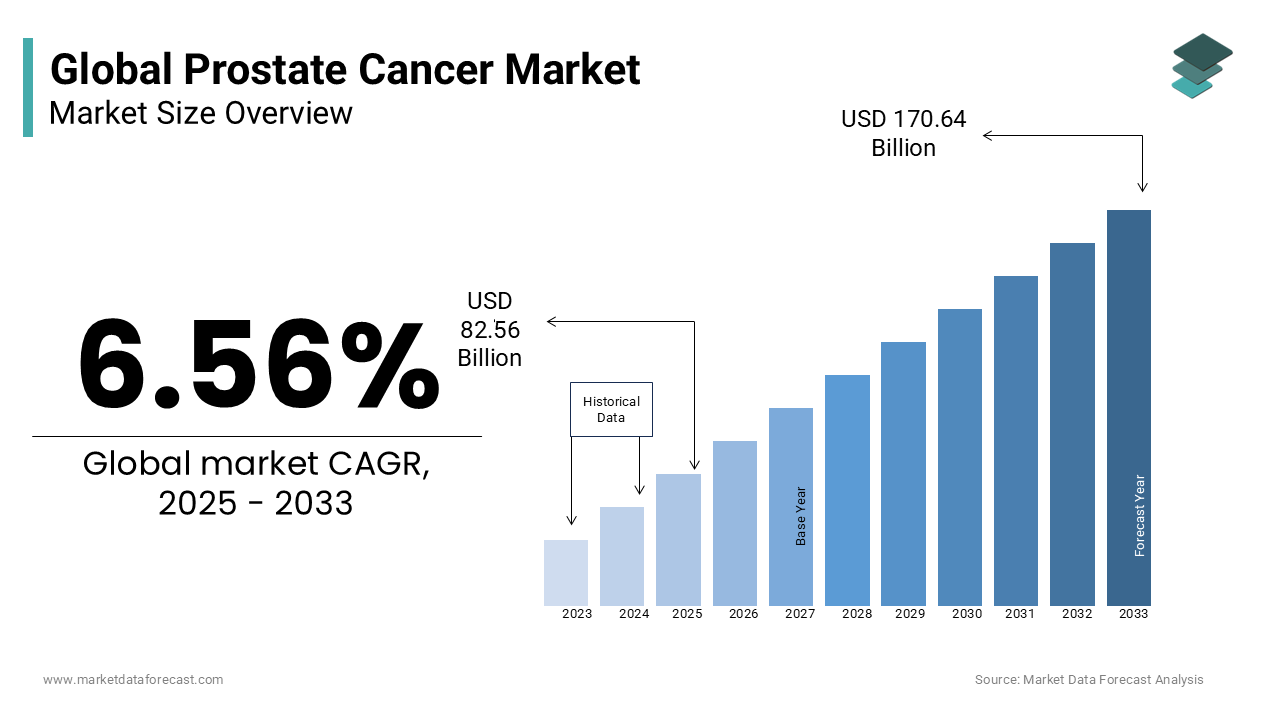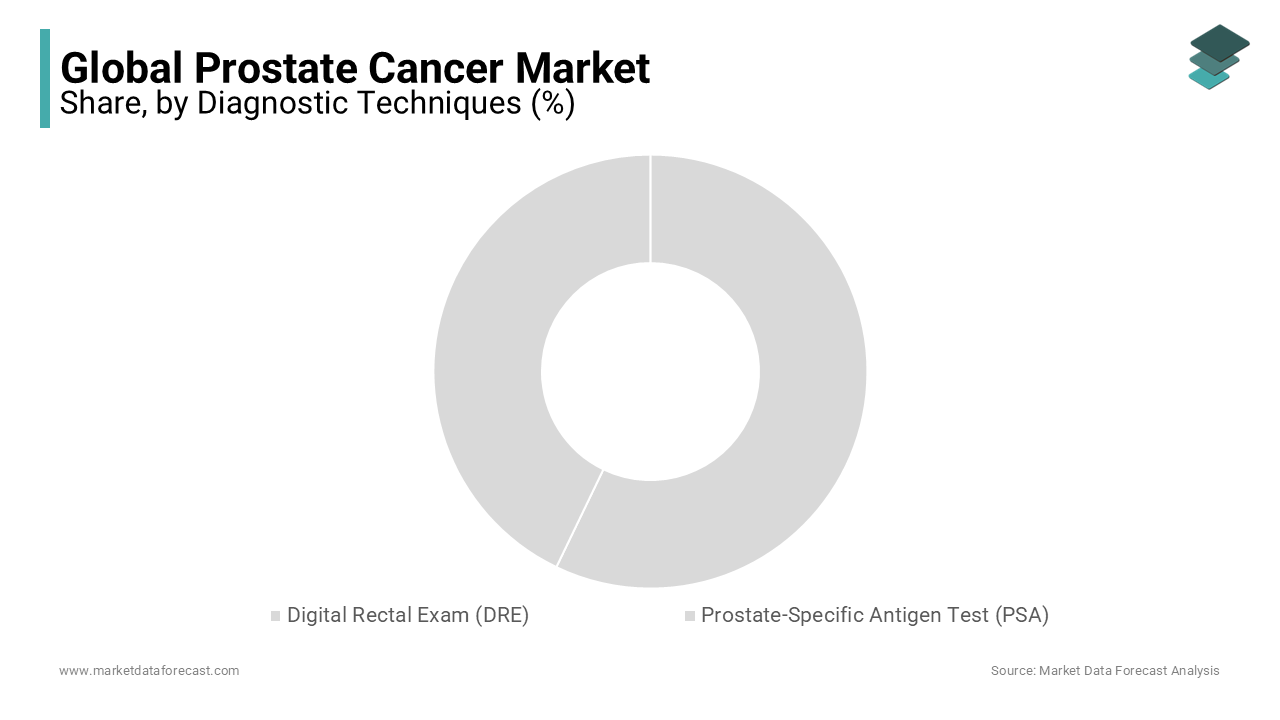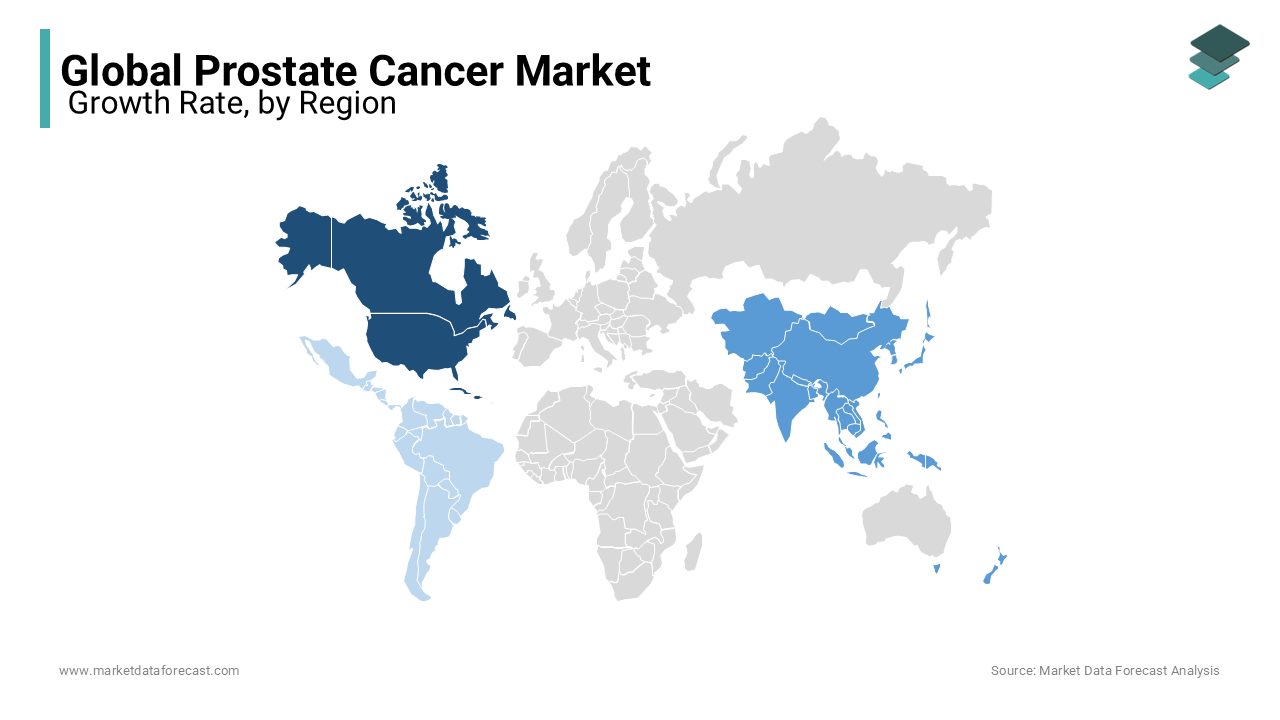Global Prostate Cancer Market Size, Share, Trends & Growth Forecast Report – Segmented By Diagnostic Techniques (Digital Rectal Exam (DRE) and Prostate-Specific Antigen Test (PSA)), Surgery, Radiation Therapy, Chemotherapy and Region - Industry Analysis From 2025 to 2033
Global Prostate Cancer Market Size
The global prostate cancer market size was valued at USD 75.40 billion in 2024. The size of the prostate cancer market is projected to be worth USD 170.64 billion by 2033 and USD 82.56 billion in 2025, growing at a CAGR of 9.5% during the forecast period.

The treatment market for prostate cancer has a high demand for novel drugs that concentrate on unmet needs, such as improved survival time, less toxicity, better progression-free survival, improved effectiveness, and lesser cost. Prostate cancer is a prostate cancer progression, a gland present in the male reproductive system. The cancer cells might reach the other parts of the body, viz., the bones and lymph nodes from the prostate. In the later stages of cancer, it can cause urination, blood in the urine, etc. Prostate cancer is most of the time diagnosed by biopsy.
MARKET DRIVERS
The growing prostate cancer patient population worldwide is majorly propelling the prostate cancer market.
Although the specific cause of prostate cancer is unknown, being overweight, obese, and having any other tumorous development history are all risk factors. Even people with cardiovascular problems are susceptible to cancer metastases. As a result, all these are the factors driving the market expansion. In the male population, prostate cancer is the second most prevalent cancer. Prostate cancer is more frequent in the senior population, and the world's population is expected to age, driving the market growth. Altering lifestyles, technological advancements in researching new techniques to fight prostate cancer, and increased funding in public and private sectors in drug advancement are some key reasons driving the global prostate cancer market growth.
Technological advancements in screening and diagnosis of prostate cancer are further boosting the growth rate of the global market.
For instance, Multiparametric MRI (MP-MRI) can significantly enhance tumor identification while confirming whether tissue biopsy is required. In addition, due to several generic goods anticipated to join the market of the expiry of patents on vital current products throughout the forecast period, Seva's result growth is expected to be fuelled by these factors. Other factors that contribute to the market's growth include an increase in demand for prostate cancer therapy and care and an increase in the use of hormonal drugs in non-metastatic castration-resistant and metastatic hormone-naive prostate cancer situations. The developing nations' untapped potential offers attractive opportunities for market expansion. The growing public awareness of prostate cancer therapy, greater R&D investment by drug developers, strong upcoming pipeline medicines and the availability of novel prostate cancer treatments are supporting the expansion of the global prostate cancer market.
Furthermore, the prostate cancer market is further anticipated to expand during the forecast period due to growth opportunities such as untapped market potential due to unmet medical treatment requirements, growing awareness among people, and advancements in the healthcare field. Further, the patent expiration of significant drugs like Zytiga will likely provide lucrative opportunities during the forecast period.
MARKET RESTRAINTS
Ever-changing reimbursement policies, extending the period of treatment, the expensive nature of combination therapies, and managing the life cycle of drugs are hampering the prostate cancer market growth. In addition, the shortage of skilled people to monitor the equipment in laboratories is slowly degrading the growth of the prostate cancer market. Besides, government bodies' frequent changes in economic strategies are hindering the market's growth rate. The market's growth is projected to be restricted by extended treatment times and low demand for prostate cancer medicines in developing nations. The market is also likely limited by the high cost of prostate cancer medicines and the low success rate of clinical trials. In addition, the high expenses of a tissue biopsy, especially during the advanced stages of a tumor, and medical consultation fees are predicted to limit growth. Furthermore, issues such as inadequate reimbursement of treatment expenses may hurt the adoption rate of treatment techniques.
REPORT COVERAGE
|
REPORT METRIC |
DETAILS |
|
Market Size Available |
2024 to 2033 |
|
Base Year |
2024 |
|
Forecast Period |
2025 to 2033 |
|
Segments Covered |
By Diagnostic Techniques, Surgery, Radiation Therapy, Chemotherapy, and Region. |
|
Various Analyses Covered |
Global, Regional & Country Level Analysis, Segment-Level Analysis; DROC, PESTLE Analysis, Porter's Five Forces Analysis, Competitive Landscape, Analyst Overview of Investment Opportunities |
|
Regions Covered |
North America, Europe, APAC, Latin America, Middle East & Africa |
|
Market Leader Profiled |
Sanofi S.A., GlaxoSmithKline, AstraZeneca, AbbVie, Varian Medical Systems, Elekta, Theragenics, Pfizer, Novartis, Roche, Bayer, Johnson & Johnson, Abbott Laboratories, and Genentech. |
SEGMENTAL ANALYSIS
By Diagnostic Techniques Insights
The prostate-specific antigen test (PSA) segment is expected to grow at a healthy CAGR during the forecast period. The PSA test is to diminish the possibility of death from cancer. The amplifying research and development activities accompany the ubiquity of castrate-resistant prostate cancer. The factors mentioned above foster market growth.

Prostate cancer is one of the most common cancers diagnosed among men aged over 45 years. The success rate of the treatment regimen is increased by timely screening and early diagnosis using PSA and DRE. The governments of industrialized nations are organizing and executing initiatives to raise awareness of screening tests for male patients over 50 years old, such as Prostate-Specific Antigen blood tests and Digital Rectal Exams (DRE). Prostate Cancer Canada was founded to assist in the research, treatment, and prevention of prostate cancer.
By Surgery Insights
A radical prostatectomy is the most common kind of prostate cancer surgery. During this operation, the surgeon removes the whole prostate gland and some surrounding tissue, including the seminal vesicles. The prostate gland and surrounding tissues are removed during radical prostatectomy. As a result, the seminal vesicles and several surrounding lymph nodes are frequently included. Prostate cancer localized to the prostate can be cured by radical prostatectomy.
By Radiation Therapy Insights
The most frequent kind of radiation treatment is external-beam radiation therapy. The radiation oncologist uses equipment outside the body to focus a beam of X-rays on the cancer area. For instance, radiation therapy for prostate cancer includes destroying tumors with high-energy beams or radioactive seeds. Brachytherapy, Intensity Modulated Radiation Therapy (IMRT), stereotactic radiosurgery, and proton therapy are the most frequent treatments for prostate cancer.
By Chemotherapy Insights
Docetaxel, the most frequent chemotherapy treatment for prostate cancer, is commonly used with prednisone, a steroid medication. Many men report improvements in disease-related symptoms such as pain, fatigue, and energy loss after starting docetaxel.
REGIONAL ANALYSIS

The North American region has contributed a prominent share in recent years and is expected to grow exponentially during the forecast period. As a result, North America dominated the worldwide market in 2023, accounting for the highest share in the global market. The primary causes for North America's market domination are the rising prevalence and high death rate of prostate cancer in the United States. In addition, this region is seeing a lot of money invested in R&D to create novel immunotherapy and targeted pharmacological treatments to treat these cancers.
Asia-Pacific is growing at the fastest CAGR in the global market due to factors such as increasing economies of the developing nations, rising youth population, rising prostate cancer cases in older people, and increasing focus on promoting preventive drugs and research initiatives. In addition, due to rising awareness of prostate cancer treatment and acceptance of prostate cancer treatment products, Asia-Pacific provides attractive opportunities for significant prostate cancer treatment market players. Furthermore, advances in healthcare infrastructure, an increase in the number of hospitals with sophisticated medical facilities, a growing R&D sector, increased healthcare reforms, and technical advancements in healthcare all contribute to market growth.
Europe accounted for a substantial share of the global market in 2024 and is anticipated to account for a substantial share of the worldwide market during the forecast period.
Latin America and MEA are anticipated to grow at a moderate CAGR during the forecast period.
KEY MARKET PLAYERS
Companies playing a prominent role in the global prostate cancer market profiled in the report are Sanofi S.A., GlaxoSmithKline, AstraZeneca, AbbVie, Varian Medical Systems, Elekta, Theragenics, Pfizer, Novartis, Roche, Bayer, Johnson & Johnson, Abbott Laboratories, and Genentech.
RECENT MARKET HAPPENINGS
- Pfizer Company completed the Array Biopharma acquisition in June 2019; Pfizer is looking forward to expanding its product portfolio and research operations regarding prostate cancer with the biotech giant Array Biopharma.
- In September 2019, The National Institute of Health revealed that prostate cancer screens might turn to biomarkers in semen. Therefore, the edible and hub have collaborated to research extracellular miRNAs. As the research outcomes, they concluded that semen exosome miRNA-based biomarkers could improve the diagnosis of prostate cancer.
- Johnson and Johnson's company has developed a drug called Erleada for treating metastatic hormone-sensitive prostate cancer and non-metastatic castration-resistant prostate cancer, which was approved by the FDA in February 2018.
- A company based in the UK launched a new advanced ultrasound imaging technique in 2018; the technique is integrated with artificial intelligence to enhance prostate cancer detection.
- Mayroy SA Company demerged from Ispen Company in December 2019.
- In 2019, Profound Medical Inc. developed a TULSA tool (MRI-guided transurethral ultrasound ablation) for treating prostate cancer and enlarged prostate at high accuracy without any side effects.
- Prostate cancer can be diagnosed accurately, more shortly, and simply by conducting urine tests at home, and the Pilot Study confirmed this was conducted very recently.
MARKET SEGMENTATION
This research report on the global prostate cancer market has been segmented and sub-segmented based on diagnostic techniques, surgery, radiation therapy, chemotherapy, and region.
By Diagnostic Techniques
- Digital Rectal Exam (DRE)
- Prostate-Specific Antigen Test (PSA)
By Surgery
- Radical Prostatectomy
- Orchidectomy
- Trans Urethral Resection (TUR)
By Radiation Therapy
- External Beam Radiation Therapy
- 3D Conformal Radiation Therapy
- Intensity Modulated Radiation Therapy
- Stereotactic Body Radiation Therapy
- Proton Beam Radiation Therapy
- Brachytherapy
- Permanent Brachytherapy
- Temporary Brachytherapy
By Chemotherapy
- Docetaxel
- Etoposide
- Vinblastine
- Carboplatin
- Vinorelbine
By Region
- North America
- Europe
- Asia Pacific
- Latin America
- Middle East and Africa
Frequently Asked Questions
Does this report include the impact of COVID-19 on the prostate cancer market?
Yes, we have studied and included the COVID-19 impact on the global prostate cancer market in this report.
Which region led the prostate cancer market in 2024?
Sanofi S.A., GlaxoSmithKline, AstraZeneca, AbbVie, Varian Medical Systems, Elekta, Theragenics, Pfizer, Novartis, Roche, Bayer, Johnson & Johnson, Abbott Laboratories, and Genentech are some of the noteworthy companies operating in the global prostate cancer market.
Which are the major players operating in the prostate cancer market?
The global prostate cancer market size is expected to grow by USD 156.16 billion by 2032 and was valued at USD 75.76 billion in 2024.
Related Reports
Access the study in MULTIPLE FORMATS
Purchase options starting from $ 2500
Didn’t find what you’re looking for?
TALK TO OUR ANALYST TEAM
Need something within your budget?
NO WORRIES! WE GOT YOU COVERED!
Call us on: +1 888 702 9696 (U.S Toll Free)
Write to us: [email protected]
